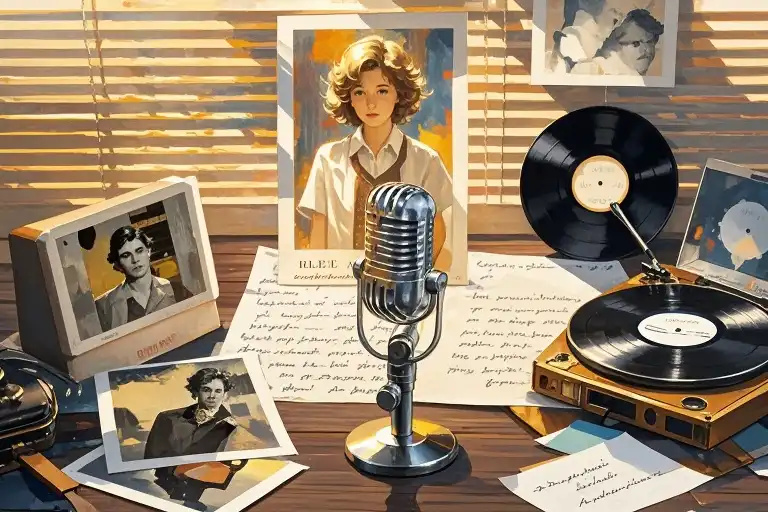The first notes of that unmistakable piano introduction still stop people in their tracks, whether it’s at a candlelit wedding ceremony or through the crackling speakers of a vintage jukebox. There’s something about the way Elvis Presley’s voice melts into the opening line – “Wise men say only fools rush in” – that makes even strangers exchange knowing smiles. How does a song recorded in 1961 for the Blue Hawaii soundtrack continue to soundtrack our most intimate moments six decades later?
Perhaps it’s the deceptive simplicity of it all – three minutes of unadorned devotion set to a melody borrowed from an 18th century French love song. Or maybe it’s the way the lyrics articulate what we’ve all felt but struggle to name: that terrifying, wonderful moment when love stops being a choice and becomes your new gravity. Hugo Peretti, Luigi Creatore and George David Weiss somehow bottled lightning when they adapted “Plaisir d’amour” into this timeless English ballad, preserving the original’s romantic essence while giving it a distinctly American vulnerability.
What began as album filler for a Hollywood musical became something far more enduring. The version we know today was reportedly recorded in just a few takes at Radio Recorders studio in Hollywood, with Elvis standing barefoot on a wooden box to get closer to the microphone. That unpolished sincerity still resonates – you can hear it in the slight hesitation before “take my hand,” the quiet surrender of “for I can’t help falling in love with you.” There are technically superior vocal performances, but few that feel quite this human.
From Honolulu recording studios to wedding playlists worldwide, the journey of this particular love song reveals how music transcends its origins. The same melody that accompanied 18th century French courtly love letters now scores proposals under neon palm trees in Las Vegas. That’s the alchemy of great songwriting – when something feels simultaneously ancient and immediate, like it was written just for this moment while having existed forever.
The Journey from French Chanson to Hawaiian Romance
The opening strains of “Can’t Help Falling in Love” carry a secret history that predates Elvis Presley’s velvet voice by nearly two centuries. That haunting melody we associate with swaying palm trees and Blue Hawaii sunsets actually began its life in 18th century France as “Plaisir d’amour,” a bittersweet meditation on love’s fleeting joys composed by Jean-Paul-Égide Martini. The original French lyrics spoke of love’s pleasure lasting “only a moment” and its pain “a lifetime” – quite different from the English version’s surrender to eternal devotion.
When Hugo Peretti, Luigi Creatore, and George David Weiss adapted the melody for Elvis’s 1961 film Blue Hawaii, they performed musical alchemy. The trio, known for transforming European folk tunes into American pop hits, slowed the tempo and simplified the chord progression, allowing Elvis’s baritone to wrap around the notes like tropical mist. Their genius lay in recognizing how this classical melody could become something entirely new when paired with lyrics about love’s inevitability rather than its transience.
Recording for the Blue Hawaii soundtrack presented unique challenges. Elvis reportedly struggled initially with the song’s delicate phrasing, wanting to avoid the schmaltz that often plagued movie musicals. The final take – recorded in just a few attempts – captured an extraordinary balance between vulnerability and strength. Listen closely to the original recording and you’ll hear the subtle Hawaiian slack-key guitar influences, a nod to the film’s setting that grounds the European melody in Pacific warmth.
What makes this musical genealogy fascinating isn’t just the centuries-spanning journey from French salon to Hollywood soundstage, but how each transformation retained the core emotional truth while refracting it through different cultural lenses. Martini’s original was a courtly meditation on love’s impermanence; Elvis’s version became an anthem to love’s overwhelming power. That the same sequence of notes could convey such different emotional landscapes speaks volumes about music’s ability to transcend its origins.
The songwriters later admitted they nearly discarded the adaptation, fearing it was too old-fashioned for a rock and roll star. Their hesitation seems unimaginable now, given how perfectly Elvis’s interpretation married classical elegance with contemporary emotion. That tension between timeless and timely ultimately became the song’s greatest strength – why it sounds equally at home in a 1960s beach movie or at 21st century weddings. The melody’s European roots give it sophistication, while Elvis’s delivery injects raw, American emotion.
Few musical adaptations demonstrate so clearly how art evolves across generations and borders. When we hear “Can’t Help Falling in Love” today, we’re actually hearing multiple histories simultaneously: an 18th century French composer’s melancholy, mid-century American songwriters’ craft, and one extraordinary vocalist’s ability to bridge eras through sheer emotional authenticity. That layered heritage explains why after six decades, the song still feels both familiar and freshly moving.
The Anatomy of Surrender: Dissecting Love’s Irresistible Pull
The opening lines hit with the quiet certainty of a late-night realization: “Wise men say only fools rush in love.” There’s something deliciously contradictory about how Elvis Presley delivers these words in Can’t Help Falling in Love – the King of Rock ‘n’ Roll, the embodiment of rebellion, singing about love as something that happens to us rather than something we choose. This tension between wisdom and foolishness forms the song’s philosophical backbone.
Verse 1: The Paradox of Love’s Wisdom
Those initial lyrics establish an immediate dialogue between generations. The “wise men” represent conventional wisdom, the accumulated experience of ages warning against impulsive emotion. Yet the song positions itself as the fool’s response – not a rejection of that wisdom, but an acknowledgment that some forces transcend rationality. The brilliance lies in how the melody undercuts the words: the descending chromatic line mirrors our inevitable surrender, musically proving what the lyrics hesitate to admit.
Chorus: The Current of Fate
“Take my hand, take my whole life too” isn’t a proposal as much as a confession of something already true. The watery imagery (“like a river flows surely to the sea”) transforms love from active pursuit to natural phenomenon. Compare this to the original Plaisir d’amour‘s more transactional approach – where the French version speaks of love’s pleasure lasting “as long as the object is faithful,” Elvis’s adaptation presents devotion as absolute and unconditional from the outset.
Bridge: The Moment of Decision
The song’s emotional pivot comes with “Shall I stay? Would it be a sin?” Here, intellectual hesitation meets emotional inevitability. That rhetorical question hangs beautifully unresolved – the answer obvious in the way Presley’s voice lingers on “sin,” stretching the word until the moral dilemma dissolves into the next declaration of love. Modern psychology might call this cognitive dissonance; the song simply calls it human nature.
Cultural Translations: From Carpe Diem to Destiny
Plaisir d’amour embodied 18th-century French romanticism’s emphasis on present joy (“the pleasure of love lasts only a moment”). The 1961 adaptation transforms this into something distinctly mid-century American – less about seizing pleasure than accepting one’s romantic fate. This shift reflects broader cultural movements: postwar idealism giving way to the more deterministic early 60s, where love becomes less a choice than a calling.
The Neuroscience of Musical Seduction
Recent studies on music and emotion help explain why this particular melody feels like falling. The stepwise descending bass line activates our brain’s pattern recognition in satisfying ways, while the harmonic rhythm (that slow, swaying 6/8 time) mimics a resting heartbeat. When researchers at McGill University mapped neural responses to romantic music, they found this combination – predictable enough to feel safe, unpredictable enough to stay interesting – triggers dopamine release similar to actual romantic attraction.
What emerges isn’t just a love song, but a musical enactment of love’s central paradox: the simultaneous experience of total freedom and complete inevitability. Every element – from the borrowed French melody to the deceptively simple lyrics – conspires to make resistance seem not just futile, but unimaginable. Later covers would reinterpret this feeling through reggae beats or jazz phrasing, but the core truth remains: some songs, like some loves, bypass our defenses entirely.
When Classics Meet Modern Echoes: The Song’s Journey Through Time
The moment Elvis Presley’s voice first floated through the speakers in 1961, “Can’t Help Falling in Love” began its quiet conquest of generations. What’s fascinating isn’t just its endurance, but how each era has reinterpreted this love ballad to mirror its own heartbeat.
Reggae Rhythms and Jazz Phrasing
UB40’s 1993 version didn’t just cover the song – it reinvented it for a new audience. Their reggae arrangement, with its offbeat guitar chops and Ali Campbell’s relaxed vocals, transformed the orchestral original into something you’d hear at a beachside bar. It became the band’s only US Billboard Hot 100 chart-topper, proving how elastic this melody truly is.
Then came the crooners. Michael Bublé wrapped the lyrics in his signature velvet tones during his 2007 tour, turning concert halls into intimate jazz clubs. His live recording captures something Elvis never emphasized – the playfulness hidden in the melody’s DNA. Meanwhile, Haley Reinhart’s 2016 a cappella version on “Postmodern Jukebox” revealed how the song could thrive without any instrumentation at all, just voices harmonizing like a 1940s radio trio.
By the Numbers
- UB40 (1993): 1 week at Billboard #1, 26 weeks on chart
- Elvis Presley (1961): Peaked at #2, became his most requested live song
- Streaming Era: Over 500 million combined streams across major platforms
The statistics tell only part of the story. What’s more revealing are the contexts where these versions thrive today – UB40’s plays at backyard BBQs, Bublé’s during winter proposal scenes in rom-coms, Reinhart’s in boutique coffee shops.
Silver Screen Second Life
Modern filmmakers keep rediscovering the song’s cinematic quality. It scored pivotal moments in “Crazy Rich Asians” (2018) and “The Broken Hearts Gallery” (2020), always during scenes where characters realize they’re already in love before their minds catch up. There’s something about that melody that visually translates to slow-motion epiphanies.
Perhaps the most unexpected revival came through Kina Grannis’ glassy, vulnerable cover for 2018’s “To All the Boys I’ve Loved Before.” Streaming platforms reported a 300% spike in searches for the original Elvis version after the film’s release – proof that every generation needs to fall in love with this song anew.
What all these interpretations share is an understanding that the core emotion – that delicious surrender – remains timeless. The packaging changes, but the heartbeat stays true. As you explore these versions, you’ll notice none dare alter the crucial line “take my whole life too” – some emotional truths are too sacred to rewrite.
The Timeless Echo of Love’s Surrender
Sixty years haven’t dimmed the quiet power of those opening piano chords. When Elvis Presley first sang “Wise men say only fools rush in” for the Blue Hawaii soundtrack in 1961, nobody could have predicted how this adaptation of an 18th-century French melody would become the universal language of vulnerable love. What makes Can’t Help Falling in Love endure isn’t just the King’s velvet voice or the Hawaiian guitar flourishes – it’s the song’s radical honesty about love being something that happens to us, not something we choose.
That confession of powerlessness resonates across generations. You’ve probably hummed it absentmindedly, heard it at a friend’s wedding, or caught a cover version in a movie scene. Maybe UB40’s 1993 reggae remake got stuck in your head, or Michael Bublé’s jazz interpretation made you sigh at a café. The song survives because it articulates what we rarely admit: love isn’t conquered through strength, but through surrender.
Here’s what stays with me – how differently we experience this song at various life stages. At twenty, it’s a hopeful serenade; at forty, a bittersweet acknowledgment; at sixty, perhaps a fond remembrance. The French original Plaisir d’amour spoke of love’s fleeting joy (“the pleasure of love lasts only a moment”), but Elvis’ version transforms it into something more profound – not just pleasure, but inevitability.
Which version speaks to you most? The raw vulnerability of Elvis’ 1968 live performance where he slows the tempo like a man drowning in emotion? Haley Reinhart’s sultry jazz take that turns surrender into something delicious? Or the way Ingrid Michaelson’s ukulele cover makes helplessness sound whimsical? There’s a version for every shade of love’s helplessness.
Before you go, let these companion songs continue the conversation:
- Unchained Melody (The Righteous Brothers) – that other great anthem of love’s overwhelming force
- At Last by Etta James – when surrender finally meets its reward
- The First Time Ever I Saw Your Face (Roberta Flack) – another moment of no return
- Come Away With Me (Norah Jones) – gentle persuasion set to music
- Perfect (Ed Sheeran) – modern vulnerability with the same heart
Leave a note about when this song caught you off guard – was it a first dance, a rainy afternoon, or the moment you finally understood what “take my hand, take my whole life too” truly demands?





